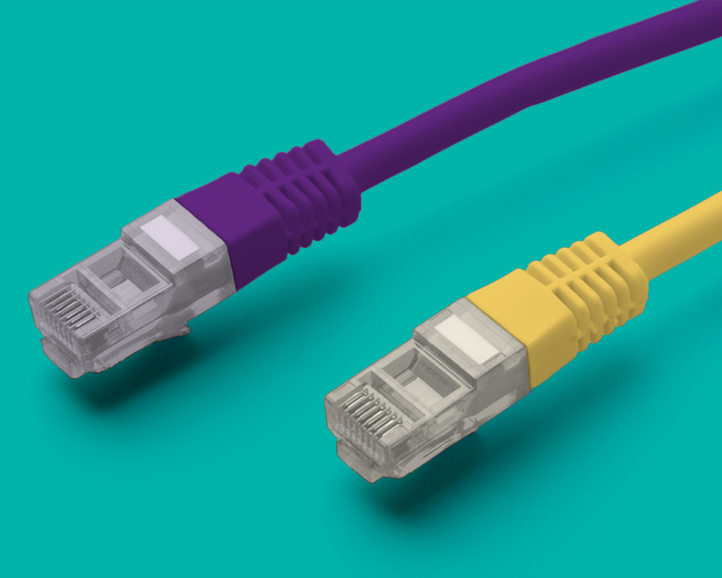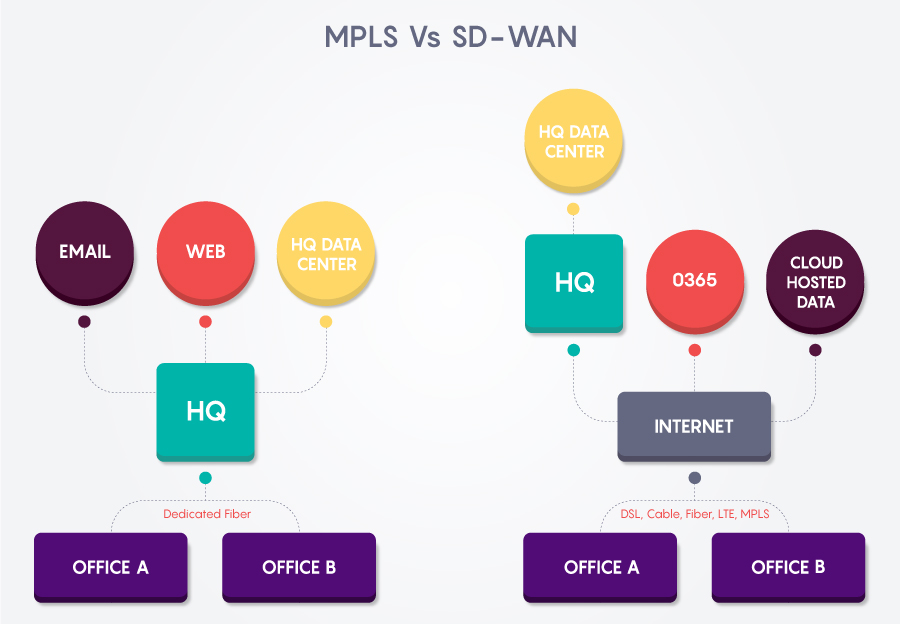MPLS vs. SD-WAN: Why SD-WAN is replacing MPLS

Summary
MPLS (Multi-Protocol Label Switching) technology is on its way out, and it’s easy to see why. From irrelevance in today’s fast-paced landscape to being expensive, businesses are dropping it. Instead, they opt for SD-WAN (Software-Defined Wide Area Network), which improves network performance and flexibility. Unsure if dropping MPLS is the right move for your business? We’ve got you covered on what you need to know about how SD-WAN represents the evolution of MPLS technology.MPLS Overview: trailblazing then, outdated now
MPLS started in the late 90s as a private network connectivity technology that marked the transition from frame relay and ATM (Asynchronous Transfer Mode) networks to an IP-based architecture. It allows multiple networks to operate on the same infrastructure but remain independent from each other.
It is a high-speed networking technology that uses labels (short fixed-length identifiers) to isolate individual networks from each other on carrier networks. It's typically only available to customers when deploying enterprise fiber or dedicated access services to branch offices and headquarters.
MPLS connection is a traditional hub-and-spoke model, with a main hub site that acts as a central point of connectivity for multiple remote spoke sites. MPLS networks support high bandwidth capacity; they are reliable and secure, making them an ideal choice for service providers as well.
However, MPLS comes with some drawbacks, including:
- Circuit-switched network architecture: This type of architecture establishes a dedicated communication channel between two devices for their communication session, reserving the entire bandwidth of the track for the two devices, even if they are not transmitting data. It's often used for voice communication like traditional telephone networks. It can be inflexible and challenging to configure, especially for large networks.
- Limited bandwidth: MPLS establishes a dedicated physical path between two endpoints before transferring data to ensure low latency and guaranteed bandwidth. However, it can be limited in bandwidth and throughput, which can be a problem for organizations with high traffic volumes or bandwidth-intensive applications.
- Expensive hardware requirements: MPLS can be expensive, requiring specialized hardware, software, and dedicated lines or circuits from the service provider.
- Hefty additional costs: Initial setup, ongoing maintenance and support costs can add up quickly, especially for businesses with multiple locations.
- Limited access types: MPLS networks are limited to a single service provider and are often only accessible using their compatible circuits or lines.
While MPLS has benefits, SD-WAN, a newer, more efficient technology, offers similar performance, reliability and more flexibility at lower costs. So, businesses considering MPLS should weigh the pros and cons before deciding.
How is SD-WAN better than MPLS?
SD-WAN utilizes software to manage network connections. It enables dynamic traffic routing over multiple transport options like Fiber or LTE/5G, choosing the optimal path according to the business or application rules and policies. But how exactly does SD-WAN architecture outperform MPLS in various aspects of WAN connectivity?
1. Infrastructure’s flexibility
The traditional MPLS network infrastructure has fixed, expensive resources, such as routers, switches and links, that limit scalability and flexibility. But with today's SD-WAN solutions, you can easily add or remove resources as needed and quickly adapt to your changing needs. SD-WAN utilizes software-defined networking to reduce the need for expensive circuits, giving you greater flexibility in resource allocation.
This enables you to:
- get the right-sized bandwidth,
- make changes to the network design in a centralized manner,
- rapidly scale up or down network usage as your business demands change,
- experience minimal downtime or reconfiguration.
Flexibility in resource allocation, including bandwidth, network devices, security measures, cloud connectivity and network optimization tools, can also help you reduce costs and improve network performance, ultimately making your business more competitive. With SD-WAN, you can easily optimize your network resources to match your changing needs without expensive hardware.
2. Easier to manage
MPLS networks are complex and difficult to manage, requiring expertise and long lead times for configuration changes. Pre-configuring and managing each connection are time-consuming, and the networks lack visibility, making it challenging to manage, optimize and resolve issues.
In contrast, SD-WAN offers a centralized management system you can manage through a single interface, giving you more visibility and control over your network. This centralization simplifies network configuration and management, allowing you to update policies or configuration settings in real-time.
Moreover, SD-WAN provides better visibility into application performance and traffic, enabling you to identify and address problems before they impact users. And SD-WAN's analytics, monitoring and diagnostic tools allow for greater network performance optimization.
3. Newer technology
MPLS is an aging technology that has evolved as a carrier technology only. It was designed for a different era of networking and falls short when handling the requirements of cloud computing, decentralized applications and various use cases seen in today's businesses. It’s inflexible and requires complete hardware replacement to update, making it costly for businesses and time-consuming to plan and execute.
On the other hand, SD-WAN is a modern, cloud-native technology that continues to evolve to meet the changing needs and technology demands of businesses. According to Gartner, 60% of enterprises will have implemented SD-WAN by 2024, compared with 30% in 2020.
SD-WAN utilizes modern virtualization and software-defined approaches. It’s cloud-friendly and highly flexible, facilitating dynamic scalability and improved performance. SD-WAN supports modern technologies like IoT, Unified Communications (UC) and virtual and augmented reality, providing a broad spectrum of business use cases.
Using modern virtualization and software-defined approaches also means that it's more future-proofed and can rapidly evolve to meet the changing demands of your business.
4. Optimized for cloud
SD-WAN optimizes connectivity to cloud applications, providing fast, reliable access to cloud resources from anywhere in the world. That is rapidly gaining momentum across businesses of all sizes, especially those with multiple locations and remote employees.
In the meantime, traditional MPLS requires backhauling traffic through a central data center, leading to increased latency and causing unacceptable delays in application response times when accessing cloud applications and services.
SD-WAN uses an intelligent routing approach to deliver workload traffic, optimizing performance and availability. It selects the best path between the two endpoints based on the application requirements and network conditions, ensuring secure, fast and highly available cloud application access.

MPLS uses a traditional hub-and-spoke model and is typically deployed on expensive enterprise fiber. In contrast, SD-WAN uses any network connection, only passing through the HQ when needed.
Think of it this way: MPLS is limited by its fixed paths, similar to train tracks that cannot be adapted. On the other hand, SD-WAN provides more flexibility, resembling cars that can take detours and always find the quickest route available. Train tracks are exclusive and expensive, while streets are abundant and accessible to any car at any moment.
SD-WAN is more adept at optimizing cloud application connectivity than traditional MPLS. Its intelligent routing approach ensures fast and reliable access to cloud resources, allowing businesses to improve performance and productivity.
5. Circuit agnostic architecture
SD-WAN is circuit (technology) agnostic which means it works with any network connection, such as broadband, LTE, Wireless and MPLS (yes, they can be combined). It allows you to use multiple connections and eliminate reliance on a single one. This avoids network downtime and slow performance risks.
Additionally, you can benefit from substantial cost savings using lower-cost, high-speed broadband connections instead of pricey leased MPLS circuits.
6. Lower total cost of ownership
Compared to MPLS, SD-WAN is a more cost-effective networking solution due to its lower bandwidth costs and reduced administrative overhead. It eliminates the need for expensive proprietary hardware, significantly saving on hardware replacements and upgrades. It also allows businesses to use cheaper broadband connections, leading to considerable savings over leased MPLS circuits.
The streamlined configuration and management processes of SD-WAN reduce administrative overheads and generate cost savings in the long run. This gives businesses more flexibility regarding their budget while providing a secure, reliable and agile network solution.
With all these cost-cutting benefits, SD-WAN is an ideal choice for any business looking for a cost-effective networking solution to get more value from their IT budget.
7. Enhanced security through a combination with SASE
If you have multiple sites, SD-WAN can be a better option than MPLS. It allows you to create a secure software-defined overlay that connects your branch offices, remote workers and cloud resources to your corporate network.
This provides a foundation for SASE (secure access service edge)-groundbreaking technology which gives you secure access to your applications and data from anywhere. Network security is crucial in today's global business landscape, where cyber threats are increasing. By integrating SD-WAN, you can protect your business from these threats and ensure a robust network security system.
RELATED
The perfect match: why SD-WAN is the foundation of SASE
8. Improved application performance
Another reason why SD-WAN is better than MPLS is that it employs intelligent routing and traffic-shaping algorithms to prioritize essential applications. Critical workloads always receive preference over other traffic, resulting in better application performance (quality of service) and superior end-user experience (quality of experience).
SD-WAN's classification capabilities can identify and classify critical workloads, prioritizing them over all other traffic. This intelligent routing technology directs time-sensitive traffic over the fastest and most reliable route, significantly reducing latency and improving overall application performance.
It also allows you to shape traffic selectively, ensuring critical applications receive guaranteed bandwidth even during peak network activity. By utilizing these techniques, SD-WAN can improve application performance and ensure users have a seamless experience, unlike its outdated counterpart.
Out with the old, in with the new
SD-WAN is game-changing tech that improves network performance, reduces costs, simplifies management and increases business agility. It's scalable, flexible and cost-effective, making it an ideal solution to stay ahead of emerging technologies.
GoCo can help you adopt this revolutionary technology to drive your business forward and increase efficiency. Learn more about SD-WAN to take advantage of all the benefits this technology can bring your company.



